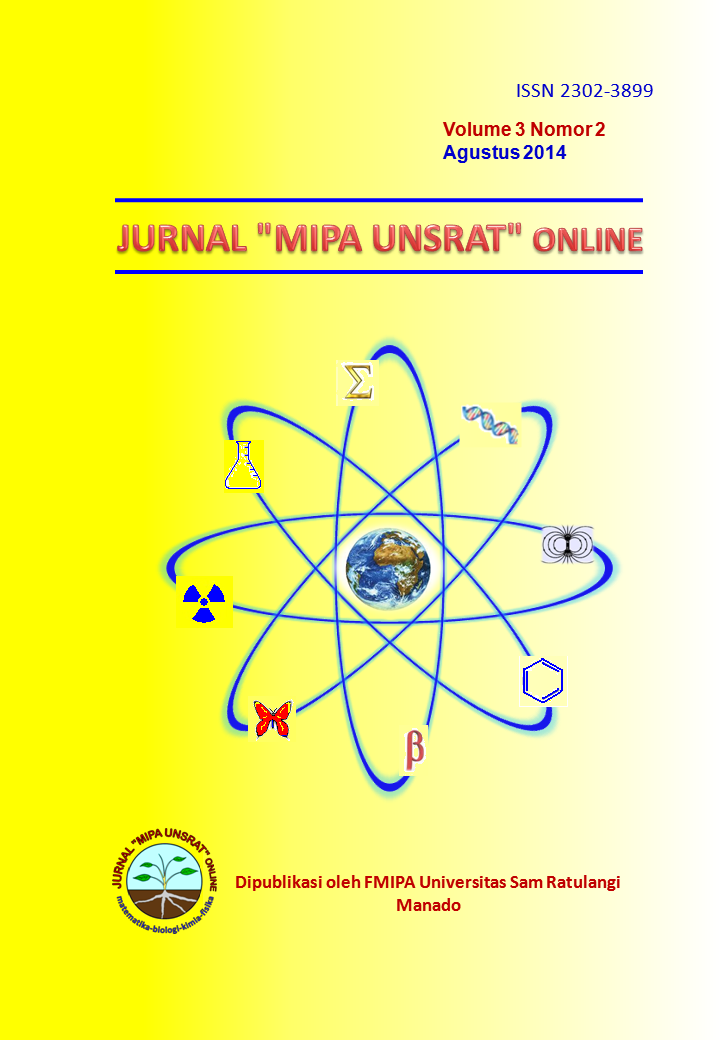Analisis Senyawa Metabolit Sekunder dan Uji Toksisitas Ekstrak Batang Bawang Laut (Proiphys amboinensis (L.) Herb.)
DOI:
https://doi.org/10.35799/jm.3.2.2014.5992Abstract
Telah dilakukan penelitian mengenai analisis senyawa metabolit sekunder dan uji toksisitas pada batang tanaman bawang laut (Proiphys amboinensis (L.) Herb.) Analisis senyawa metabolit sekunder dilakukan dengan skrining fitokimia untuk senyawa alkaloid, flavonoid, triterpenoid, steroid, saponin dan tanin pada ekstrak batang tanaman bawang laut segar dan kering dan selanjutnya dianalisis menggunakan spektrofotometer UV-VIS. Penentuan toksisitas ekstrak batang tanaman bawang laut menggunakan metode Brine Shrimp Lethality Test (BSLT) dengan hewan uji Artemia salina Leach sebagai bioindikator. Pada skrining fitokimia diperoleh flavonoid dan steroid positif sedangkan alkaloid, saponin triterpenoid dan tanin negatif. Analisis spektofotometer UV-VIS ekstrak etanol menunjukkan puncak serapan pada 304,40 dan 284,50 nm. Data pengujian toksisitas diperoleh dari analisis Lethality Concentration 50 (LC50) yang dilakukan dengan metode probit menggunakan perangkat lunak SPSS 20. Hasil uji toksisitas ekstrak batang tanaman bawang laut menunjukkan bahwa ekstrak segar maupun kering bersifat sangat toksik dengan nilai LC50 kurang dari 30 ppm, yaitu: 9,978 ppm untuk batang kering dan 3,980 ppm untuk batang segar.
A research has been done on the analysis of secondary metabolites and toxicity examination on the stems of the sea onion (Proiphys amboinensis (L.) Herb.). Analysis of secondary metabolites carried out with the phytochemical screening for alkaloid compounds, flavonoids, triterpenoids, steroids, saponins, and tannins in extracts of fresh and dried stems of the sea onion, then analyzed using UV-VIS spectrophotometer. The toxicity determination of stems extract of the sea onion plant was done by using Brine Shrimp Lethality Test (BSLT) with Artemia salina Leach as bioindicator. Phytochemical screening showed positive test for flavonoids and steroids while alkaloids, saponins, triterpenoids, and tannins were negative. UV-VIS spectrophotometer analysis on ethanol extract showed peaks at 304,40 and 284,50 nm. Data of the toxicity examination was obtained from the analysis of Lethality Concentration 50 (LC50) which were performed with the probit method using SPSS 20. Results of toxicity examination of sea onion stems extract showed that fresh or dried extract are very toxic with LC50 values ​​of less than 30 ppm, namely: 9,978 ppm for fresh stems and 3,980 ppm for dried stems.






